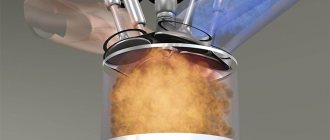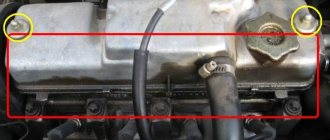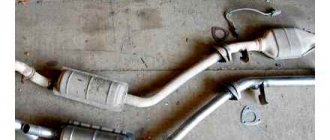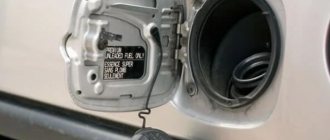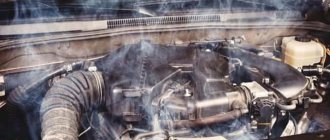What happens if you mix several types of antifreeze from different brands? Is it possible to mix them with each other at all? What does this mean? What is the difference between blue antifreeze and red? We will try to cover these and other questions in this article so that the reader has a comprehensive answer and does not engage in “alchemy”, mocking his vehicle in the process.
Let’s say right away that it is possible to mix antifreeze of different brands if certain conditions are strictly observed. In other cases, you are almost guaranteed to ruin the radiator within a couple of years. In most cases it will be impossible to recover. Therefore, think three times before subjecting your vehicle to various tests.
What do different colors of antifreeze indicate?
The main purpose of the liquid is cooling. Antifreeze is used to reduce the heating of working elements. For this purpose, the liquid is poured into the cooling system, which is found in every car.
Replacing antifreeze
To produce antifreeze compounds, a glycol base is used, to which water and additives are added. Additional elements allow you to create liquids of different compositions.
To distinguish mixtures, manufacturers use dyes:
- Red (G 12). These are carboxylate group refrigerants. Additives stop the corrosion process that has already begun inside the cooling system, but they do not eliminate corrosion themselves.
- Blue (TL, G 11). Standard samples. The composition is as close as possible to antifreeze.
- Green (G 11). These are products that are produced with silicate additives. After entering the cooling system, they form a special protective film that prevents wear of the elements.
- Yellow, orange, pink (G 13). This is a group of hybrid or combined liquids based on propylene glycol. Modern liquids of this group are considered more environmentally friendly than substances based on ethylene glycol.
It is worth noting that lobrid antifreezes G12++ and G13 are suitable for all cars without any problems.
Summarize. Antifreeze liquids are initially colorless. Manufacturers add dyes so that antifreeze can be distinguished by color. The base of all liquids is a glycol base. It is this that prevents it from freezing or boiling.
Violet
Few of us have seen them in person, but such means also exist. They appeared relatively recently - in 2012. Belong to the 13th group. Purple represents lobrid antifreezes that do not contain ethylene glycol. It is believed to be highly poisonous. But how does it ensure heat removal if the main composition is without ethylene glycol? Instead, manufacturers use more environmentally friendly propylene glycol. It is less toxic and environmentally friendly. As for other components, purple antifreeze contains silicates and carboxylic acid, already known to us as an anti-corrosion agent in previous groups.
Is it possible to mix antifreeze with antifreeze?
Antifreeze is a coolant with specific properties. It was invented before antifreeze for cooling purposes. Later, when an environmentally friendly composition on a different basis appeared, automobile production stopped using antifreeze.
Mixing antifreeze and antifreeze
It is customary to replace one fluid with another only after the system has been completely flushed, but there are situations when a simple top-up is required. For example, a leak has occurred, but there is no way to add the same substance. If you add a small amount of antifreeze to the cooling system with old antifreeze, then nothing bad will happen. But experts consider the option of a complete fluid change to be more preferable. That is, before pouring antifreeze, it is better to drain the residue and rinse the channel with distilled water.
Mixing antifreeze with antifreeze or replacing one with the other without flushing the cooling system can lead to corrosion or the appearance of sediment that clogs the channels and deteriorates the quality of the coolant.
Characteristic
First of all, we note that any coolant, whether foreign or Russian, is colorless. This factor does not affect the quality in any way. “But why then are they multi-colored?” - you ask. Which antifreeze to choose - red, green, blue? What is the difference? Manufacturers classify their products in this way. Any liquid is distinguished by the presence of components that prevent it from freezing at low temperatures. This figure can range from minus 15 to minus 40 degrees Celsius. Below we will look at the differences.
Is it possible to mix antifreeze of different colors?
What will happen if you pour antifreeze of a different color into a car, in what cases it may be needed - let's look at examples.
To begin with, you should consider the basic rules of work:
- Liquids with the same base can be mixed.
- If one of the liquids is silicate-based, then mixing is not recommended.
In practice, when mixing liquids of different classes, sediments begin to actively interact with each other, creating additional elements. This does not happen right away. The deposit forms after the engine has warmed up to operating temperature several times.
The consequence of mixing manipulation is most often clogging of the radiator channels and the deposition of small particles on engine parts.
Is it possible to mix different standards?
Here the situation is more interesting. If antifreeze of different colors, but of the same group, can be interchanged, then different products can cause unexpected reactions in the system, only aggravating the situation of your radiator and other components of the cooling system.
Is it possible to mix antifreeze of different subgroups? You need to understand that G11 and G12 have completely different additives: the former are aimed at creating a film, the latter at eliminating rust. It is almost impossible to control the mixing of active components. Yes, sediment may not fall, but the film will significantly reduce the cooling efficiency. This is because green antifreezes reduce the diameter of pipes and other components. The temperature drops, as do the cooler characteristics. A kind of “thrombus” may even form, which can cause the radiator to fail.
It all depends on the final volume of the diluent liquid. If you pour up to half a liter, then there will be no consequences. But in the future you need to fill in the “native” cooler.
Is it possible to mix antifreezes with different properties?
Mixing coolants with different properties is fraught with undesirable consequences. Compositions with silicate additives based on ethylene glycol behave unpredictable in combination with modern propylene glycol antifreezes. The substances form deposits that negatively affect engine performance.
The characteristic properties of antifreeze are the degree of corrosion, freezing point, boiling point, and color of the liquid.
Experts emphasize that the only acceptable situation is when you have to add antifreeze of a different color, but only in small quantities. The need for this arises if there is a coolant leak. There is no necessary composition at hand, but it is necessary to add liquid according to the operating conditions of the vehicle. If you add coolant of a different color to the main antifreeze within 0, 1 or 0.2 liters, the changes will be insignificant.
What does antifreeze consist of?
Regardless of color, any modern antifreeze is approximately 80% a mixture of monohydric alcohol (ethylene glycol or propylene glycol) and water. This composition can withstand temperatures up to +196 °C without boiling, and as for the freezing threshold, it depends on the ratio of the components and ranges from -11 °C to -65 °C. It should be noted that, according to the international classification, depending on what type of alcohol is used in antifreeze (ethylene glycol or propylene glycol), it is divided into three types:
- G11;
- G12;
- G13.
The remaining 20% in any modern antifreeze is a variety of additives. They are necessary in order to protect the metal and rubber parts that this liquid comes into contact with from corrosion and destruction under the influence of alcohol. The effects of additives vary depending on the type of antifreeze. In order for this difference to be determined visually, different types of liquids are painted in different colors.
Is it possible to mix antifreeze of different brands?
The coolant industry is constantly evolving. The color classification cannot be taken as a permanent basis. For example, Volkswagen produces mixtures according to its own standards, which are not applicable for BMW vehicles.
Different types of antifreeze
If you are an experienced car owner, then it is most profitable to use fluids from one manufacturer. When mixing substances of different brands, you should be especially careful. An excess of some compounds can neutralize the work of others and lead to an undesirable result that affects the operation of the engine. The result of the experiments may be foaming, in which case repairs will be required in a car service center.
About color
The color of antifreeze is more of a distinctive component. As a rule, now it does not carry any semantic load. Although many manufacturers, including Volkswagen, tried to introduce color differences between antifreezes, they even had their own recommended colors.
So G11 was almost always green.
G12 – red (or bright orange)
G13 – purple
Although many manufacturers now do not follow the path of Volkswagen and paint antifreeze in the colors they please, this is because there is no strict standardization. So G11 can be either blue or reddish. G12 – green. And G13 is not only purple, but also yellow .
Colors were introduced so that the driver could easily and simply distinguish between antifreezes, but the confusion between manufacturers is now increasingly confusing the common man.
Several rules for mixing antifreeze
Do not mix substances until you have learned the basic rules:
- Green and red antifreezes cannot be mixed. If you had to do this for a number of reasons, you will need to completely flush the cooling system. In addition, when mixing red and green substances, the carboxylate base loses its properties, that is, the anti-corrosion function will not work.
- Red refrigerants can be mixed with each other.
- Despite the fact that hybrid refrigerants are not recommended to be mixed with others, adding 20% of the composition is allowed in extreme cases. But as a result of mixing, additive conflict may occur, which means that the freezing point will shift.
After long-term use, even in good formulations, precipitation may occur due to oxidation, temperature changes, contact with metals and subsequent mixing with other types of antifreeze.
In any case, mixing the compositions leads to the formation of precipitation. Only those substances that are created on the same basis react well with each other.
How are O.Zh. different?
The difference, as I said above, is the additives. That is, various additives are added to the same liquid and the desired composition is obtained.
- G11 - ethylene glycol is used, usually the cheapest coolant, with a small additive package. This class was assigned the color green. By the way, colors were introduced so that liquids of different classes could be distinguished. Before this, the liquids were colorless.
- G12 - ethylene glycol and carboxylate compounds are used. Due to the fact that the anti-corrosion film is created only in the hot spots, and does not cover all internal surfaces, heat removal when using this antifreeze is more effective than that of G11. Best suited for high-speed and temperature-loaded engines. Due to a more advanced package, e-liquids of this class are more expensive. This class was assigned the color red.
- G13 - polypropylene glycol is used. This is a more environmentally friendly product (non-toxic, decomposes faster). Europe is pursuing environmental friendliness, which is why they create such products. The most expensive coolants. This class is assigned a yellow or orange color. In Russia, not a single manufacturer makes G13 class liquids. They are not old enough to chase the environment for that kind of money.
But most Russian and Asian manufacturers do not adhere to this classification. Take the same TCL: it has both green and red fluids of the G11 class, but they differ in the additive package (red is more advanced).
Therefore, the manufacturer introduced color divisions to differentiate the product for the end customer.
It is worth noting that additives in the compositions are needed precisely in order to remove the negative destructive effect of ethylene glycol and water, because this combination is extremely active and can destroy any metal surface, and even more so a tube or radiator wall. And additives restrain this fervor, removing the negative impact.
Roughly speaking, there are now only two types of additives:
- These are protective . They protect the tubes and pipes inside, forming a film on their surface that prevents metal parts from collapsing. Mainly used in G11 and our antifreeze.
- It is anti-corrosion . There is no film formation here, but it turns out that all the work happens when rust begins to appear. These additives block the outbreak by simply sealing it. Used in G12 and G12+.
To be fair, now there is also a third type - hybrid additives (G13 antifreeze), this is when two effects, protective and anti-corrosion, are combined at once, that is, they are simply mixed in the right proportion.
Antifreeze mixing table
For the convenience of car owners, manufacturers have created a special compatibility system.
| Top-up/cooling system | G 11 | G 12 | G 13 |
| G 11 | + | — | + |
| G 12 | — | + | — |
| G 13 | + | + | + |
When it becomes necessary to replace the coolant, it is better to drain the old composition and flush the channel. Only after this can new antifreeze be added.
What happens if you mix the G11 and G12 groups
Mixing different types of antifreeze can cause problems over time.
The main consequences of mixing silicate and carboxylate classes are:
- corrosion of internal surfaces of the cooling system;
- foaming of the working fluid;
- engine overheating;
- increase in fuel consumption up to 5%;
- blocking of internal combustion engine channels;
- clogging of radiators and other components of the cooling system;
- pump replacement;
- reduction of engine oil service life;
- other malfunctions.
Only in cases of extreme necessity can different types be added.
To mix or not to mix, that is the question
At the end of the article, you need to make a small digression, which cannot be considered a rule, but it is worth knowing about it.
The age of new technologies and innovative solutions brings us qualitatively new products every day. Likewise, a new generation of coolant, made using the latest technologies, has completely new properties, one of which is possible compatibility with other antifreezes. Moreover, this information, for the most part, is displayed on the product label. But still, even taking this information into account, and using only high-quality, latest developments in the field of all kinds of lubricants and coolants in your car, you should not take risks and use antifreeze with completely different properties for topping up. Even if it's the same color.
What is the best thing to do in a situation of painful choice - what kind of antifreeze to add and whether it is possible to mix them in principle. The simplest thing to do to begin with is simply to look at the manual included with each car and carefully study the manufacturer's recommendations. If the manual is lost, or the car is used, and what the previous owner put into it remains a mystery, then there is only one solution and the most correct one. This is a complete change of coolant in the system. In addition, the quality and service life of antifreeze can be determined by its color. If it has radically changed its original color, then there is no need to think about it - just change it.
Green
It is created on the basis of inorganic components, represented by phosphates and silicates, and contains organic ingredients. In addition to these elements, it contains a small amount of carboxylic acid and borates. Refers to the G11 standard, which designates it as a hybrid. The period of use is limited to 3 years.
The peculiarity of these antifreezes is their ability to envelop the internal walls in the cooling tract, which contributes to a more effective fight against corrosion. This merit goes entirely to the inclusion of carboxylic acid.
The main disadvantages of this coolant are the need to change at least once every 2-3 years, the creation of fine deposits that clog the thin channels of the cooling system, and a decrease in heat dissipation due to the film formed.
What brings this solution closer to class G12 is the percentage of carboxylic acid that can be contained in different proportions. There are “G11 +” and “G11 ++” green antifreezes.4
Video
The following video describes in detail about antifreeze and rules of use:
(CO) helps prevent overheating of the power unit in the car. Therefore, you need to monitor the amount of substance in the tank. When adding it, it must be taken into account that if antifreeze is mixed without taking into account their composition and class, this can lead to problems in the operation of the cooling system. Accordingly, to overheating of the internal combustion engine. We will tell you more about how to properly mix refrigerants below.
[Hide]
Red
A solution is created from organic carboxylic acids. The peculiarity of the substance is the creation of localized lashes in places where corrosion foci occur. The thickness of the protective film does not exceed 1 micron. It is characterized by a long service life - 5 years until the next change. Belongs to class G12 according to the Volkswagen classification. It has better protective properties against cavitation and metal corrosion than silicate or hybrid analogues.
In addition to excellent properties in the fight against defects formed on metal surfaces, red coolants cannot be used as a prophylactic agent or as protection for the cooling system. They are best used in brass and copper radiators, but can even be dangerous for aluminum structures.
The right choice of colors
Having received information about the composition of the liquid, some owners independently determine the mixing capabilities. It is important to pay attention to the recommendations of car manufacturers, which indicate the desired composition and sometimes the color of the consumable.
This is due to the fact that car companies test their products for compatibility with popular engine coolers. Based on long-term testing, the performance of the machines, the risk of corrosion or compatibility with other additives are determined. This also makes it possible to determine interactions with other similar liquids.
It is important to know that it is not possible to determine its quality by the color of antifreeze, since this characteristic relates only to conditional information and does not have a significant effect on the chemical composition.

